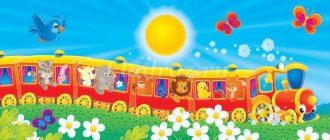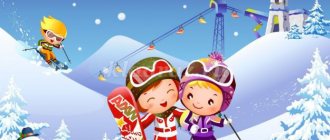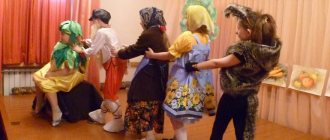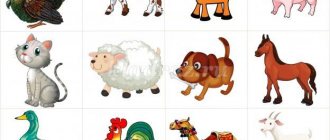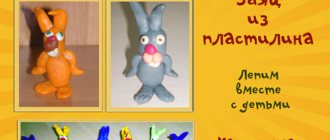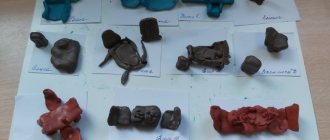Senior group. Senior preschool age. Children 5-6 years old
Summary of a lesson using ICT “Here comes winter” in the senior group Purpose: To expand and enrich children’s knowledge about the features of winter nature; create a holistic picture of the world. Tasks: Educational: 1. Clarify and deepen children’s knowledge about the living and inanimate nature of their native land in winter; 2. Improve the lexical and grammatical structure of speech; 3….
GCD for children of senior preschool age using ICT “Good friends” Topic: “Good friends”
Goal: to consolidate the child’s ethical ideas about
“friendship”
,
“generosity”
,
“politeness”
using specific examples. Educational • Clarify and systematize children's knowledge about the rules of etiquette: the ability to say hello, make friends, resolve conflicts, share with a friend. •…
Summary of a lesson using ICT in the middle group “Visiting the forest dwellers”
Summary of a lesson using ICT in the middle group “Visiting the forest dwellers”
Target:
Give children ideas about the hedgehog: its appearance, movements, nutrition, habits; expand and deepen existing knowledge.
Tasks:
Educational:
To form a holistic picture of the world through getting to know the hedgehog: its appearance, movement, nutrition, habits, with its offspring, to broaden the horizons of children.
Fix the names of baby animals.
Continue to develop coherent speech, the ability to answer questions, activate children’s vocabulary (beast, cub, hedgehog, hedgehogs, form children’s vocabulary (hedgehog, hedgehog, hedgehogs)
.
Educational:
Continue to develop skills in cognitive and research activities.
Develop memory, thinking, logic (the ability to draw conclusions and conclusions, attention (the ability to see the main thing, motor activity, tactile sensations, fine motor skills, creative skills and abilities.
Continue to develop children's gross motor skills.
Educational:
Cultivate an interest in the lives of animals, the ability to empathize, a desire to help...
Foster a caring attitude towards living nature.
Develop the ability to listen to each other.
Foster a value-based attitude towards one’s own work and the work of other children.
Integration of educational areas: cognitive development, speech development, social and communicative development, physical development, artistic and aesthetic development.
Materials and equipment:
Models of trees, model of a door. Presentation showing: “Photos of hedgehogs, a story about their lifestyle, appearance, nutrition, habits.”
Toys: cat, bird, squirrel, hedgehog
;
Handout: Hedgehogs cut out of paper, clothespins for “needles”
(model of a clearing for hedgehogs.)
Musical accompaniment:
Music Center.
Disc (melody “Sounds of Nature”
,
"Voices of nature. Hedgehog"
).
Preliminary work:
Looking at illustrations of a hedgehog.
Reading of S. Marshak’s poems “A Quiet Tale”
,
"The Tale of a Smart Mouse"
.
Guessing riddles about forest animals.
Progress of the lesson.
Start of class in the group room
.
Educator: Guys, guests have come to us, let's say hello.
There is a good sign to give greetings to everyone in the morning.
Red sun. Hello!
Clear sky. Hello!
People are adults and children.
Hello to you from the bottom of my heart! (together)
There is a knock on the door.
Educator: Guys, hear them knocking. Let's see who came to us.
They open the door. The children see that there is no one there, only traces of someone’s legs.
Educator: Guys, whose tracks are these?
Presumable answers from children.
Educator: Interesting! Let's follow his trail and find out who knocked on the door and why and ran away.
Summary of educational activities with ICT on cognitive development in the senior group of kindergarten
Abstract of educational activities with ict on cognitive development (familiarization with the environment) for children of senior preschool age.
Voronkova Natalya Anatolyevna, municipal educational institution kindergarten No. 278, Volgograd, teacher
Can be used by teachers of senior preschool groups, teachers of correctional senior preschool groups to expand and consolidate children’s ideas about wild animals, their appearance, and way of life.
Abstract of educational activities with ICT on cognitive development “Spiky and furry inhabitants of the forest” for children of senior preschool age.
Goal : Expand and consolidate older children’s ideas about wild animals, their appearance, habits, and lifestyle. Objectives: Correctional and educational: To consolidate knowledge about wild animals. Introduce children to how wild animals prepare for winter. Correctional and developmental: Develop attention, memory, logical thinking, coherent speech, curiosity and imagination. Correctional and educational: To cultivate interest and love for the animal world, a respectful and caring attitude towards nature, a sense of empathy for everything living and beautiful. Materials : laptop, projector, screen, artificial Christmas trees, paper autumn leaves, pictures depicting a needle, a feather, presentation “Prickly and Fluffy”, audio recording “Sounds of the Autumn Forest”, “Merry Country of Dwarves” by V. Gladkov, two cut-out pictures in A3 format depicting a hedgehog, illustrations depicting nuts, mushrooms, apples, a barrel of honey, raspberries, carrots, seeds, a squirrel, a hedgehog, a bear, a hare, a mouse, two baskets, fir cones for the game “Help the Squirrels,” colored sticks, toothpicks, matches – for laying out silhouettes of animals. Preliminary work: reading M. Prishvin “Forest Guests”, “Fluff”, conversation with children about the life of wild animals, looking at paintings depicting wild animals, d/game “Whose Cub?”, d/game “Choose a Word”, d/ game “Whose tail, whose head?”, guessing riddles about wild animals, reading Russian folk tales about wild animals. Progress of the NOD: Educator : Guys, today is a wonderful autumn day and I invite you to take a walk in the forest. We will be helped by our assistant - the magic screen. Look at the beautiful autumn leaves under your feet. How nice it is to walk on them. ( Children with a teacher walk in a group to the quiet melody “Sounds of the Autumn Forest” and reach two Christmas trees
).
Educator : What beautiful forest trees. There are some pictures on them. He takes pictures from the Christmas trees and shows them to the children
.
The first picture shows a needle on the second fluff (feather). I wonder what that would mean? I think guys these are tips for us. We will probably meet something or someone with something sharp and soft fluffy. Wait, do you hear someone rustling? Who do you think it could be? Children: Maybe a mouse. Educator : To find out, guess the riddle: “Under the pines, under the fir trees, there is a bag of needles.” Children : Hedgehog. Educator: That's right, hedgehog. Remember what a hedgehog looks like. Children : Prickly, small. Educator : Look at the screen. ( The presentation slide show begins) 1 Slide
: The hedgehog’s muzzle is small, with an elongated nose, all covered with short gray hairs.
The beady black eyes seem attentive and intelligent, but the hedgehog sees poorly. Slide 2
: But he has an excellent sense of smell!
The hedgehog's paws are short with small claws. Slide 3:
The hedgehog wears prickly needles on its back.
They save him from his enemies. The hedgehog will curl up into a prickly ball, bristling with its sharp needles - try and eat it! Slide 4
: The hedgehog makes its home near old stumps, covering its burrow with dry leaves.
He doesn’t make provisions for the winter. With the onset of cold weather, he climbs into his warm house and sleeps until spring. 5 Slide
: The hedgehog feeds on worms, mice, frogs, poisonous snakes, beetles, and lizards.
Educator: Look, guys, I’ll show you how you can show the figure of a hedgehog, repeat with me. ( The “Hedgehog” exercise for the development of fingers is performed: press the fist of the right hand to the palm of the left. Connect the thumbs of both hands. Spread the remaining fingers of the left hand. Change hands.) Educator : Now let’s do finger gymnastics: “Talking with a hedgehog” - Why are you a hedgehog, they are doing the “hedgehog” exercise.
So prickly?
-This is me just in case. Change hands.
Do you know who my neighbors are?
The clasped fingers are clenched and unclenched.
Foxes, wolves, and bears!
Perform the “fox” exercise, then imitate the movements of a bear.
(B. Zakhoder)
Educator : Guys, do you remember what a hedgehog looks like? This means that you will cope with the task “Collect pictures”. Now I will divide you into two teams and give you two cut-out pictures of a hedgehog, let's see which team can handle it first. (Children collect pictures cut into 8-10 parts) Educator: Now can you tell me what a hedgehog looks like? What helps him escape from his enemies? What does it eat? Children's answers
.
Educator: Let's move on. (Children with the teacher walk further in the group to the music of “Merry Country of the Dwarves” by V. Gladkov, and do physical education)
It’s time for us to take a break, stretch and breathe.
(Deep inhale and exhale.) Turn your head, And away is all the fatigue! One-two-three-four-five, You need to stretch your neck. (Rotate your head in one direction and the other.) Stand up straight. They leaned over. One - forward, and two - back. We stretched ourselves. Straightened up. We repeat everything. (Bend forward and backward.) And then we squat. This is important, we know it ourselves. We stretch our knees, We exercise our legs. (Squats.) (V.I. Kovalko) Stop near a hoop lying on the floor with pine cones scattered in it. Educator : Someone forgot the cones? Children : Squirrels. Educator : Do you know what a squirrel looks like? Children answer
.
Educator : Look at the screen. ( Starts slide show) 5 Slide:
The squirrel is an agile animal.
In spring and summer, their fur coats are reddish-golden; by winter, the fur becomes silvery-gray, thick, and warm. 6 Slide
: But the squirrel’s main pride is its magnificent fluffy tail.
The tail not only decorates and warms the squirrel on rainy days. He helps her when jumping. 7 Slide
: The squirrel makes its nest from thin twigs and often winters in a deep hollow.
Slide 8:
Stocks up at the end of summer and autumn.
He loves to eat nuts, seeds of coniferous trees - cedar, pine, spruce. Loves berries, mushrooms, buds, inflorescences. Slide 9:
In the spring, squirrels give birth to baby squirrels.
The mother squirrel diligently looks after them, feeds them, protects them from forest predators: crows and martens. Squirrels' enemies are hawks, owls, and eagle owls. He is saved by hiding among the dense branches. Educator : Now repeat after me the tongue twister: The squirrel baked pancakes and served them to the squirrels. The squirrel's pancakes were a success. The plates were empty in an instant. Children repeat the tongue twister.
(Kulikovskaya T.A.)
Educator : Well done! I suggest you children guess who else forgot their supplies and return them to the owner ( shows children illustrations depicting nuts, mushrooms, apples, a barrel of honey, raspberries, carrots, seeds
)
Children give answers, if the answer is correct, next to the picture depicting supplies a picture appears with the image of the owner: a squirrel, a hedgehog, a bear, a hare, a mouse. Educator: Well, let’s help the squirrels collect cones into baskets? (points to the cones that lie on the floor). Let's call this game "Help the squirrels collect cones." Children are divided into two teams, each team has a basket. Opposite the team there are cones in hoops on the floor. You need to transfer one cone to the basket, whoever is faster. Educator : We did a good deed, we helped the squirrels. Now remember what the mother of the baby squirrels is called? When does a mother squirrel have babies? What are the enemies of the squirrel? How does a squirrel escape from its enemies? What does a squirrel eat? Children answer
.
Educator : Well done, you remembered everything well. Let's now play the game "It happens - it doesn't happen." I will say a sentence containing a true or false judgment. You guys, if necessary, correct the errors. So, listen: the fox is red, the wolf is angry, the hare is brave, the hedgehog is fluffy, the squirrel is fat, the turtle runs fast, the wolf lives in the forest, the pig grunts, the hare flies, the bear sleeps in a den, the wolf sleeps in a hollow. Children correct and give correct answers. Educator : And you coped with this task wonderfully. Our journey is coming to an end, it's time to return. Finally, let's lay out figures of a hedgehog or a squirrel from colored sticks, toothpicks and matches. Children approach the tables, where there is a large selection of materials, and begin to lay out animal figures. You can give sample cards (diagrams) Educator : Let's admire your little animals. I really like how you laid out the squirrels and hedgehogs. Guys, do you remember that at the beginning of the trip we found pictures with a needle and fluff on the Christmas trees, did you guess what they meant? Children's answers
.
Educator : That's right, that means we will meet a prickly hedgehog and a fluffy squirrel. You were all great, you answered well and completed all the tasks, and deserved a sweet treat for this! Literature: 1. Zelenova N.G., Osipova L.E.
We live in Russia. Civic-patriotic education of preschool children. – M.: “Publishing house Scriptorium 2003”, 2008. – 96 p. 2. Kovalko V.I. ABC of physical education minutes for preschoolers. Middle, senior, preparatory groups. – M.: VAK, 2011, – 176 p. 3. Kulikovskaya T.A. 40 new tongue twisters. Workshop on improving diction/ - M.: Publishing House GNOM and D, 2008 - 44 p. 4. Metelskaya N.G. 100 physical education minutes in speech therapy classes. – M. TC Sfera, 2007. – 64 p. 5. Pimenova E.P. Finger games/E.P. Pimenova. – Rostov n/d: Phoenix, 2007. – 221, p. – (Your child’s world) 6. Filimonova O.Yu. Development of a preschooler's vocabulary in games: A manual for speech therapists, educators and parents. – SPb., “DETSVO – PRESS”, 2007. – 128 pp., illus. 7. Shorygina T.A. What animals are in the forest?!: a book for educators, tutors and parents. – M.: “Publishing house GNOM and D”, 2008 – 96 p. (Acquaintance with the outside world and speech development) Presentation on the topic: Spiny and furry inhabitants of the forest
We recommend watching:
Summary of GCD for introducing older preschoolers to the work of the poet Fet Summary of plot-based GCD in physical education for children of the senior group Summary of GCD in the senior group of compensatory orientation GCD in kindergarten for older preschoolers
Similar articles:
Summary of GCD in the senior group on the topic “Communication”
Summary of GCD in the senior group of kindergarten on the topic “Relaxation”
Summary of a lesson on cognition in the senior group on the topic “Dairy products”
Summary of a lesson on cognition in the senior group on the topic “Construction professions”
Abstract of educational activities for cognition in the senior group of kindergarten on the topic “Russian folk crafts”
